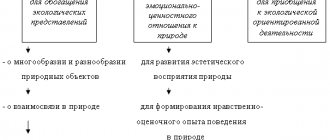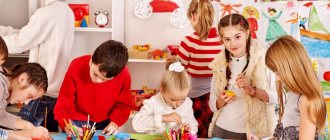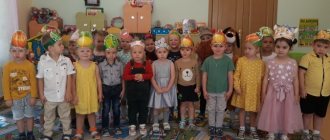The role of folklore in the education of preschool children
The role of folklore in the upbringing of children
Purpose of the material: This article introduces teachers to the importance of folklore for the development and education of preschool children, with experience in this area. The article may be of interest to kindergarten teachers, teachers working with “special” children, and parents. Children's folklore plays an important role in the education of preschool children, the leading feature of which is the unity of poetics, music, manner of performance and function of the work (M.N. Melnikov). Its peculiarity is determined by folk artistic thinking and the requirements of folk pedagogy. For example, in sayings, nursery rhymes, children's songs, and jokes, improvisation, imagery, rhythm and instruction are combined (M.Yu. Novitskaya). This is a kind of school of play, designed to provide the child with an adequate way of understanding the world around him (A.M. Martynova). Children's folklore is, first of all, a culture of dialogue; it is focused on interaction, the need to listen and respond. The fairy tale, created for children's edification, was attracted by fiction that carries deep life meaning. Children's calendar folklore provided an intonational, poetic, figurative form of communication with the outside world. Children's folk games, songs, nursery rhymes, jokes, ditties, fables, tongue twisters, conspiracies, pure sayings, counting rhymes, riddles are a means of mental, moral, aesthetic, emotional development of preschool children, they represent the core of children's culture, a universal form of communication between children, children and adults. Today, society is faced with the task of creating conditions for caring and preserving children's language, children's traditions, and children's subculture. We built our work on the following principles: • taking into account the age characteristics of children when selecting content, topics of classes, tasks of education and training; • ensuring emotional and psychological comfort for children; • respect for the personality of each child: Folklore material, taking into account the age capabilities of children, is included in various types of children's activities, enriches the educational and educational process, contributes to the cognitive and emotional development of our students. A long-term plan of activities and entertainment has been drawn up for the group, taking into account the periods of the agricultural folk calendar. The plans include fairy tales, songs, tongue twisters, riddles, boring tales, chants, folk games, lullabies, nursery rhymes, pesters, jokes. All this is present in any type of children’s activity: play, artistic speech, theatrical, educational, and in routine moments. The study of calendar folklore is carried out through the participation of children in calendar holidays. Scenarios of folk holidays are dedicated to different cycles of the agricultural calendar. The organization and holding of national holidays occupy a special place. The holiday is a synthesis of various types of folk collective creativity. Holding folk festivals, gatherings, and evenings is a continuation of the students’ work in thematic classes to introduce them to the origins of Russian folk culture, allowing them to show their initiative and creative potential. In the process of holding the holiday, knowledge is consolidated and expanded, and students apply it in practice, in collective creativity, because the holiday includes a living word, sounds, colors, rhythm, movement, form, i.e. children directly participate in various types of folk art. Not a single ritual holiday is complete, of course, without playing Russian folk instruments. These simple instruments become magical in the hands of children, come to life and find their own voice. Introducing children to new instruments, performing songs and dances on them contributes to their musical development. Since the work is aimed at enriching children with knowledge about folklore, in physical education classes they also turn to Russian folk art. The use of children's folklore in working with children has several directions, but their definition is conditional, because problems are solved in a complex manner. The first direction is the establishment and formation of trusting, kind, affectionate relationships between adults and the child. The main thing in a relationship is a clear manifestation of love and affection. Adults should actively use stroking gestures, which relieve tension and alienation in relationships and help establish contact with the child, filled with good feelings and calm. The second direction is for children to perform various movements when pronouncing folk nursery rhymes, jokes, chants, sayings, etc., which contribute to the development of fine motor skills. The development of fine motor skills and hands is inextricably linked with the mental development of children and the development of their speech. In addition to nursery rhymes and jokes that develop fine motor skills and the child’s hand, we teach him using children’s folklore and various expressive movements. The child learns to be emotional both in speech and in showing movements. Thanks to children's folklore, the emotional sphere of the child is enriched; we help him express emotions that are adequate to the content of the text. A special place in working with children to master the material of children's folklore is given to jokes, fun, and children's joy. In this regard, boring fairy tales and, of course, games, teasers, and humorous dialogues are indispensable. Thus, we see that works of children's folklore are not only diverse in genres, but they are also diverse in themes and tasks. Children's folklore stimulates the child's creative expression and awakens imagination. Creativity enriches the personality, the child’s life becomes more interesting and meaningful. Games based on children's folklore give children extensive experience in the skills of expressive speech and expressive movements. Children realize their experience in theatrical activities. Folklore is close and interesting to children, and we help them, by becoming familiar with folklore, to play and play, gain intelligence, become kinder, understand jokes, humor, and rejoice. Teachers can use children's folklore in individual and group lessons, during leisure hours, and on holidays. Children's folklore will help speech therapists in establishing contact with children and creating favorable conditions for teaching children clear and expressive speech. Music directors also need games with folk words, because They help develop children's sense of rhythm, expressiveness of movements, and creative abilities. The greatest excitement and interest is caused by turning to games. They develop initiative, organizational skills, and resourcefulness. Many ancient games involve singing. It decorates them, promotes quick memorization, and gives rhythmic coherence (“Burn, Burn Clearly,” “Pie,” “Karavai,” “Kostroma,” “Two Grouse”). Folklore is an extremely valuable didactic material in the aesthetic education of the younger generation. Vivid images of good and evil in songs, fairy tales, and choruses are accessible and understandable to children. Moreover, children do not just listen to fairy tales and songs, they themselves are involved in fairy-tale play, they are participants and directors of musical and playful and vocal compositions, fairy tales, and puppet shows. The game corresponds to the nature of the student; In the process of playing, the child organically learns new musical images, acquires skills and abilities, and develops his imagination. Moreover, the development of abilities occurs as if by itself, in an entertaining and exciting form of play, which deprives the educational process of edification. If a child was born and grew up on his native side, among Russian birches, heard Russian songs, sang carols, congratulated his relatives on the bright holiday of Easter, was brought up in work, mercy, kindness, in respect for elders, relatives and the Earth, this commandment of the ancestors is in his soul will save, only bring joy and happiness with it.
We recommend watching:
Scenario of a folklore holiday for schoolchildren Folklore sketch “Bereshchenye” Development of emotionality of young children through familiarity with Russian folklore Development of divergent thinking in first-graders
Similar articles:
Folklore festival in elementary school
School adaptation for first graders
How to organize the educational process in a preschool educational institution
Development of creative abilities of preschool children in theatrical activities
Emotional development of a senior preschooler
Development of speech and memory
Small folklore forms are distinguished by the variety of rhythms, richness of vocabulary and regularity of repetition. Thanks to this, the child involuntarily remembers phrases that are simple in form, which he perceives as part of the game. Nursery rhymes become the first poems learned by heart, even if parents did not set such a goal at all.
The richness of images, the brightness and unusualness of the words used may be unusual for the baby at first; not everything will be clear to him. The parents’ task is to explain the meaning of what was said, to tell a story about each proverb or saying. In this way, the child’s vocabulary is replenished. Psychologists and teachers agree that the earlier the acquaintance with folk art begins, and the more often parents engage with the baby, the greater the likelihood that the sooner he will begin to speak and describe his thoughts and emotions in words.
Establishing a routine and increasing self-esteem
Problems with sleep and nutrition, and excessive excitability of the baby directly depend on the daily routine, which is sometimes not so easy to form. The child didn’t want to eat, then didn’t want to wash, didn’t go to bed on time, and with such difficulty the schedule set by the parents was thrown off literally overnight. Nursery rhymes and jokes will also help correct the situation. They will not only distract you from whims and tears, but also remind you of the ritual:
“Clever Katya, eat some sweet porridge...”
“Ay tu-tu-tu-tu, don’t cook the porridge…”
“So the animals are sleeping...”
“Sleep, sleep, child Vanyushenka...”
In order for the baby to get used to the standards of hygiene, neatness and independently performing simple procedures, such as combing or washing, many sayings have also been invented:
“Oh, okay, okay, okay, we’re not afraid of water...”
“Tap, open, wash your nose...”
“Clean water washes Sasha’s face, Anechka’s palms, and Alyosha’s fingers”
“Grow your braid to your waist...”
And the most unobvious benefit of most sayings is increasing the child’s self-esteem almost from infancy. The fact is that many nursery rhymes mention names, and parents easily replace them with the baby’s name in an affectionate form. Children begin to realize themselves, to understand that the poem was written about them, in their honor, which means that they are an independent person. At first, this happens unconsciously, but then the idea that he deserves the respect and attention of adults, that he is valuable and important, becomes the norm.
Songs and music
Children encounter their first folk songs even at an unconscious age, when their mother sings lullabies to them. As they get older, they learn about the culture of their country through music. It is during this period of first acquaintance that musical taste is formed, which will develop over the years. It is much easier to learn a song by heart than poetry; it is more figurative and full of emotions. When the baby can repeat the composition himself, it’s time to move on to dancing. To begin with, you can simply dance in circles to the music, raising and lowering your arms, closing and opening the circle. Over time, the baby can be given more freedom so that he can decide for himself how to move to the music, relying on internal sensations. And this is already an element of creativity! And it is through musical compositions that a child’s first acquaintance with jokes and humor can occur. Rarely used in the educational process, ditties can teach a child to understand the funny. The main thing is the correct selection of the “repertoire”.
Logic and definition of the meaning of words
Another way to develop speech, and at the same time logic, is riddles. They are amazing because they are always connected with the surrounding reality. This means that the baby is not just looking for an answer, but at the same time learning about the world, and not from other people’s words, but thanks to his own mental activity. By solving riddles, children learn to build connections between objects from their everyday life, analyze and generalize, and find common properties of objects. In addition, some concepts in the Russian language are polysemantic, and riddles use the figurative meaning of the word, so children learn to recognize which meaning is appropriate in a given situation.





